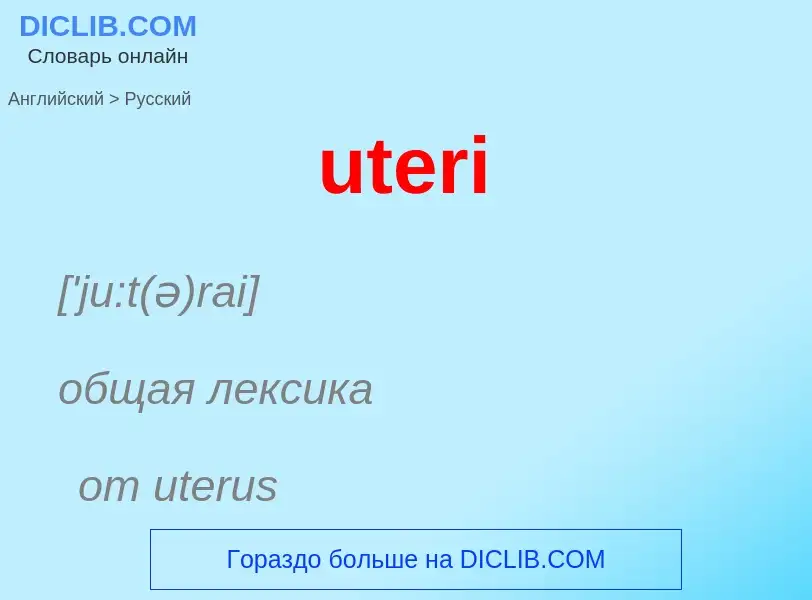Tradução e análise de palavras por inteligência artificial ChatGPT
Nesta página você pode obter uma análise detalhada de uma palavra ou frase, produzida usando a melhor tecnologia de inteligência artificial até o momento:
- como a palavra é usada
- frequência de uso
- é usado com mais frequência na fala oral ou escrita
- opções de tradução de palavras
- exemplos de uso (várias frases com tradução)
- etimologia
uteri - tradução para russo
['ju:t(ə)rai]
общая лексика
от uterus
общая лексика
шейка матки
Definição
Wikipédia
The uterus (from Latin uterus, plural uteri) or womb () is the organ in the reproductive system of most female mammals, including humans, that accommodates the embryonic and fetal development of one or more embryos until birth. The uterus is a hormone-responsive sex organ that contains glands in its lining that secrete uterine milk for embryonic nourishment.
In the human, the lower end of the uterus is a narrow part known as the isthmus that connects to the cervix, leading to the vagina. The upper end, the body of the uterus, is connected to the fallopian tubes, at the uterine horns, and the rounded part above the openings to the fallopian tubes is the fundus. The connection of the uterine cavity with a fallopian tube is called the uterotubal junction. The fertilized egg is carried to the uterus along the fallopian tube. It will have divided on its journey to form a blastocyst that will implant itself into the lining of the uterus – the endometrium, where it will receive nutrients and develop into the embryo proper and later fetus for the duration of the pregnancy.
In the human embryo, the uterus develops from the paramesonephric ducts which fuse into the single organ known as a simplex uterus. The uterus has different forms in many other animals and in some it exists as two separate uteri known as a duplex uterus.
In medicine, and related professions the term uterus is consistently used, while the Germanic-derived term womb is commonly used in everyday contexts. Events occurring within the uterus are described with the term in utero.


![[[Transvaginal ultrasonography]] showing a uterine fluid accumulation in a [[postmenopausal]] woman. [[Transvaginal ultrasonography]] showing a uterine fluid accumulation in a [[postmenopausal]] woman.](https://commons.wikimedia.org/wiki/Special:FilePath/Endometrial fluid accumulation, postmenopausal.jpg?width=200)







![mucosa]]. mucosa]].](https://commons.wikimedia.org/wiki/Special:FilePath/Cervix uteri, breastfeeding woman after 2 births.jpg?width=200)
![A nulliparous woman's ectocervix showing [[cervical ectropion]], visible as the darker red mucosa surrounding the cervical os. Viewed on speculum exam A nulliparous woman's ectocervix showing [[cervical ectropion]], visible as the darker red mucosa surrounding the cervical os. Viewed on speculum exam](https://commons.wikimedia.org/wiki/Special:FilePath/Nulliparous cervix with ectropion.jpg?width=200)
![The squamocolumnar junction of the cervix, with abrupt transition: The ectocervix, with its stratified squamous epithelium, is visible on the left. Simple columnar epithelium, typical of the endocervix, is visible on the right. A layer of [[connective tissue]] is visible under both types of epithelium. The squamocolumnar junction of the cervix, with abrupt transition: The ectocervix, with its stratified squamous epithelium, is visible on the left. Simple columnar epithelium, typical of the endocervix, is visible on the right. A layer of [[connective tissue]] is visible under both types of epithelium.](https://commons.wikimedia.org/wiki/Special:FilePath/Cervix Normal Squamocolumnar Junction (565238127).jpg?width=200)

